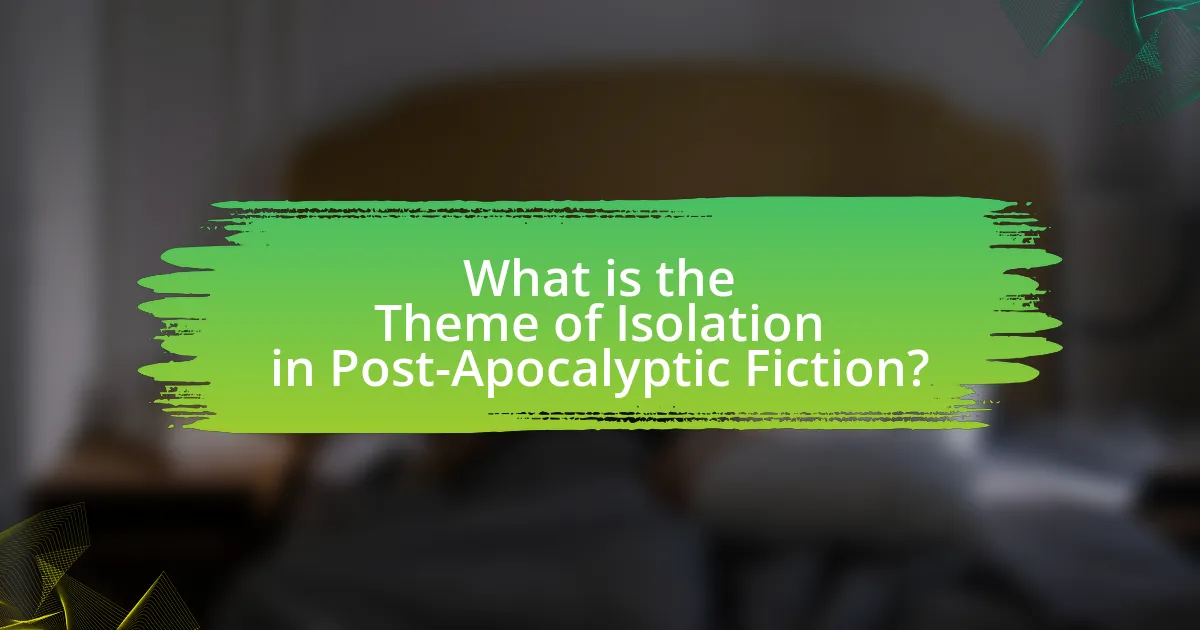The article examines the theme of isolation in post-apocalyptic fiction, highlighting its emotional and psychological impacts on characters navigating a world devastated by catastrophe. It discusses how isolation manifests through physical separation, emotional detachment, and the struggle for survival, as illustrated in works like Cormac McCarthy’s “The Road.” The article further explores the psychological effects of isolation, the role of setting, and the implications for character development and relationships. Additionally, it analyzes different types of isolation, narrative techniques, and the unique perspectives of various authors, ultimately revealing the profound consequences of isolation on both individuals and societal structures.

What is the Theme of Isolation in Post-Apocalyptic Fiction?
The theme of isolation in post-apocalyptic fiction highlights the profound emotional and physical separation experienced by characters in a world devastated by catastrophe. This theme often explores the psychological impacts of solitude, as characters grapple with loss, survival, and the absence of societal structures. For instance, in Cormac McCarthy’s “The Road,” the father and son navigate a desolate landscape, emphasizing their isolation from humanity and the struggle to maintain hope amidst despair. Such narratives illustrate how isolation can lead to both vulnerability and resilience, shaping character development and moral dilemmas in the face of overwhelming adversity.
How does isolation manifest in post-apocalyptic narratives?
Isolation in post-apocalyptic narratives often manifests through physical separation from society, emotional detachment, and the struggle for survival in desolate environments. Characters frequently experience loneliness as they navigate abandoned landscapes, highlighting their disconnection from former social structures. For instance, in Cormac McCarthy’s “The Road,” the protagonists face not only the absence of other humans but also the emotional toll of their isolation, which is depicted through their interactions and the bleakness of their surroundings. This theme is reinforced by the portrayal of empty cities and the remnants of civilization, emphasizing the stark reality of a world devoid of community and support.
What are the psychological effects of isolation on characters?
Isolation significantly impacts characters psychologically, leading to increased anxiety, depression, and cognitive decline. Research indicates that prolonged isolation can result in feelings of loneliness, which may exacerbate mental health issues and impair social functioning. For instance, a study published in the journal “Psychological Science” found that individuals experiencing social isolation reported higher levels of distress and lower life satisfaction. Additionally, characters may exhibit paranoia or hallucinations due to the lack of social interaction, as evidenced in various post-apocalyptic narratives where isolation leads to distorted perceptions of reality. These psychological effects underscore the profound consequences of isolation on mental health and character development in literature.
How does the setting contribute to feelings of isolation?
The setting in post-apocalyptic fiction significantly contributes to feelings of isolation by depicting desolate landscapes and abandoned environments. These settings often feature empty cities, barren wastelands, or remote locations that emphasize the absence of human life and community. For instance, the portrayal of a once-thriving urban area now reduced to ruins creates a stark contrast that heightens the sense of loneliness experienced by characters. Additionally, the harsh conditions, such as extreme weather or scarcity of resources, further isolate individuals, making it difficult for them to connect with others. This combination of physical desolation and environmental challenges reinforces the theme of isolation, as characters navigate through a world stripped of social structures and support systems.
Why is isolation a significant theme in post-apocalyptic fiction?
Isolation is a significant theme in post-apocalyptic fiction because it highlights the psychological and social impacts of catastrophic events on individuals and communities. This theme often illustrates how characters cope with loneliness, loss, and the breakdown of societal structures, which can lead to profound existential reflections. For instance, in Cormac McCarthy’s “The Road,” the isolation of the father and son emphasizes their struggle for survival in a desolate world, showcasing the emotional toll of their solitude. Such narratives often serve to explore human resilience and the innate need for connection, making isolation a critical lens through which the human condition is examined in the aftermath of societal collapse.
What does isolation reveal about human nature in extreme circumstances?
Isolation in extreme circumstances reveals that human nature is fundamentally driven by survival instincts, social connections, and psychological resilience. In isolated settings, individuals often experience heightened anxiety and fear, which can lead to both altruistic behaviors and selfish actions, depending on the context. For instance, studies have shown that prolonged isolation can result in significant psychological stress, leading to a breakdown of social norms and an increase in aggression or paranoia, as evidenced by the Stanford prison experiment conducted by Philip Zimbardo in 1971. This experiment illustrated how situational factors can influence behavior, revealing that isolation can strip away societal constructs, exposing raw human instincts. Additionally, research indicates that social bonds become even more crucial in isolation, as seen in survival scenarios where cooperation often enhances chances of survival, highlighting the duality of human nature in extreme conditions.
How does isolation affect character development and relationships?
Isolation significantly impacts character development and relationships by intensifying emotional struggles and altering interpersonal dynamics. In post-apocalyptic fiction, characters often face extreme loneliness, which can lead to profound introspection and personal growth, as seen in works like “The Road” by Cormac McCarthy, where the father-son relationship deepens through shared adversity. Additionally, isolation can create tension and conflict in relationships, as characters may become distrustful or paranoid, exemplified in “The Walking Dead,” where isolation leads to fractured alliances and moral dilemmas. These narratives illustrate that isolation not only shapes individual identities but also redefines how characters connect with one another, often highlighting the fragility of human relationships in dire circumstances.

What are the Different Types of Isolation Depicted in Post-Apocalyptic Fiction?
Different types of isolation depicted in post-apocalyptic fiction include physical isolation, social isolation, and psychological isolation. Physical isolation occurs when characters are cut off from the outside world due to environmental disasters or societal collapse, as seen in works like “The Road” by Cormac McCarthy, where the landscape is barren and inhospitable. Social isolation arises from the breakdown of community and relationships, often leading to loneliness and despair, exemplified in “Station Eleven” by Emily St. John Mandel, where survivors struggle to connect in a world devoid of civilization. Psychological isolation reflects the internal struggles of characters dealing with trauma and loss, as portrayed in “The Girl With All the Gifts” by M.R. Carey, where characters grapple with their identities in a transformed world. These forms of isolation serve to highlight the human condition and the impact of catastrophic events on individuals and society.
How do physical and emotional isolation differ in these narratives?
Physical isolation refers to the tangible separation from others, often depicted through characters being geographically distanced or cut off from society, while emotional isolation involves a lack of meaningful connections and feelings of loneliness despite physical proximity to others. In post-apocalyptic narratives, physical isolation is illustrated by characters surviving in desolate environments, such as abandoned cities or remote locations, which emphasizes their vulnerability and struggle for survival. Conversely, emotional isolation is portrayed through characters who, even when surrounded by others, feel disconnected due to trauma, loss, or mistrust, highlighting the psychological impact of their circumstances. This distinction is evident in works like “The Road” by Cormac McCarthy, where the father and son face both the harsh realities of a barren landscape and the emotional toll of their isolation from humanity.
What examples illustrate physical isolation in post-apocalyptic settings?
Examples of physical isolation in post-apocalyptic settings include the desolate landscapes in Cormac McCarthy’s “The Road,” where the characters navigate a barren world devoid of civilization, and the isolated communities in “The Walking Dead,” where survivors are cut off from the outside world due to zombie hordes. In “The Road,” the lack of infrastructure and the presence of dangerous elements create a sense of extreme isolation, emphasizing the struggle for survival. Similarly, in “The Walking Dead,” fortified locations like the Alexandria Safe-Zone illustrate how survivors attempt to create barriers against external threats, reinforcing their physical separation from the broader, chaotic world. These examples highlight how physical isolation shapes the characters’ experiences and interactions in post-apocalyptic narratives.
How is emotional isolation portrayed through character interactions?
Emotional isolation is portrayed through character interactions by depicting a lack of meaningful communication and connection among individuals. In post-apocalyptic fiction, characters often experience profound loneliness, which is illustrated through their inability to share their thoughts and feelings, leading to misunderstandings and conflict. For example, in Cormac McCarthy’s “The Road,” the father and son struggle to express their fears and hopes, resulting in a deep emotional distance despite their physical proximity. This portrayal highlights how the collapse of societal structures exacerbates feelings of isolation, as characters are unable to form supportive relationships, ultimately reinforcing their emotional detachment.
What role does societal collapse play in the theme of isolation?
Societal collapse significantly amplifies the theme of isolation by stripping away social structures and community support systems. In post-apocalyptic fiction, such as Cormac McCarthy’s “The Road,” the breakdown of civilization leads to characters experiencing profound loneliness and disconnection from others. This isolation is often depicted through the characters’ struggles to find companionship in a world where trust is scarce and survival is prioritized over relationships. The absence of societal norms and the chaos that ensues create environments where individuals are forced to confront their solitude, highlighting the psychological impact of living in a fragmented world.
How does the breakdown of community contribute to individual isolation?
The breakdown of community significantly contributes to individual isolation by severing social connections and support systems. When communities disintegrate, individuals lose access to shared resources, emotional support, and social interactions, leading to feelings of loneliness and disconnection. Research indicates that social isolation can have detrimental effects on mental health, increasing the risk of depression and anxiety. For instance, a study published in the American Journal of Public Health found that individuals with weak social ties are more likely to experience adverse health outcomes, underscoring the importance of community in fostering individual well-being.
What are the consequences of isolation on societal structures?
Isolation leads to the fragmentation of societal structures, resulting in weakened social bonds and increased conflict among remaining groups. In isolated environments, communities often experience a breakdown of trust, as individuals become more self-reliant and suspicious of outsiders. This phenomenon is evident in post-apocalyptic fiction, where characters frequently face moral dilemmas that challenge their humanity, leading to the emergence of authoritarian leadership or tribalism as survival mechanisms. For instance, in Cormac McCarthy’s “The Road,” the collapse of societal norms illustrates how isolation can strip away empathy and cooperation, ultimately resulting in a struggle for power and resources among survivors.

How is Isolation Explored Through Various Literary Techniques?
Isolation is explored in post-apocalyptic fiction through techniques such as symbolism, character development, and narrative structure. Symbolism often manifests in desolate landscapes or abandoned settings, representing the emotional and physical separation of characters from society. Character development highlights the psychological effects of isolation, showcasing how characters adapt or deteriorate in solitude, as seen in works like “The Road” by Cormac McCarthy, where the bond between father and son underscores the struggle against loneliness. Narrative structure, including fragmented timelines or unreliable narrators, can reflect the disorientation and alienation experienced by characters, enhancing the theme of isolation. These techniques collectively illustrate the profound impact of isolation on human experience in a post-apocalyptic context.
What narrative devices are used to convey isolation?
Narrative devices used to convey isolation include first-person perspectives, fragmented timelines, and stark imagery. First-person perspectives immerse readers in the protagonist’s solitary experience, emphasizing their emotional detachment from the world. Fragmented timelines create a disjointed narrative that mirrors the chaos and disconnection felt by characters in post-apocalyptic settings. Stark imagery, such as desolate landscapes and abandoned structures, visually reinforces the theme of isolation by depicting environments devoid of life and human connection. These devices effectively illustrate the profound sense of loneliness and alienation characteristic of post-apocalyptic fiction.
How does imagery enhance the theme of isolation in post-apocalyptic fiction?
Imagery enhances the theme of isolation in post-apocalyptic fiction by vividly depicting desolate landscapes and abandoned structures, which evoke a sense of loneliness and abandonment. For instance, descriptions of empty cities, overgrown vegetation, and crumbling buildings create a stark visual representation of a world devoid of human life, emphasizing the characters’ solitude. This use of imagery not only illustrates the physical environment but also reflects the emotional state of the characters, reinforcing their feelings of despair and disconnection. Studies in literary analysis show that such imagery serves to immerse readers in the characters’ experiences, making the theme of isolation more palpable and impactful.
What role does symbolism play in representing isolation?
Symbolism plays a crucial role in representing isolation by using objects, settings, or characters to convey the emotional and psychological states associated with being alone. In post-apocalyptic fiction, for instance, desolate landscapes often symbolize the absence of human connection and the breakdown of society, reflecting the characters’ internal struggles with loneliness. Specific examples include abandoned buildings representing lost hope and empty streets signifying the absence of community. These symbols effectively illustrate the profound impact of isolation on individuals, enhancing the narrative’s emotional depth and allowing readers to grasp the severity of the characters’ experiences.
How do different authors approach the theme of isolation?
Different authors approach the theme of isolation in post-apocalyptic fiction by exploring the psychological and social ramifications of being cut off from society. For instance, Cormac McCarthy in “The Road” depicts isolation as a profound emotional burden, illustrating the struggle for survival and the bond between father and son amidst desolation. In contrast, Octavia Butler’s “Parable of the Sower” presents isolation as a catalyst for resilience, where the protagonist seeks community and connection in a fragmented world. Additionally, Stephen King’s “The Stand” examines isolation through the lens of a pandemic, highlighting both the physical separation and the longing for human connection. These varied approaches underscore isolation’s multifaceted impact on human behavior and relationships in extreme circumstances.
What are the unique perspectives of notable authors in this genre?
Notable authors in post-apocalyptic fiction offer unique perspectives that highlight the psychological and societal impacts of isolation. For instance, Cormac McCarthy in “The Road” emphasizes the bond between father and son as a means of survival amidst desolation, illustrating how isolation can intensify human connections. Similarly, Octavia Butler in “Parable of the Sower” presents a dystopian world where isolation leads to the emergence of new belief systems, showcasing resilience in the face of societal collapse. These perspectives underscore the multifaceted nature of isolation, revealing both its destructive and transformative potential in human experience.
How do cultural backgrounds influence the portrayal of isolation?
Cultural backgrounds significantly influence the portrayal of isolation by shaping individuals’ perceptions, experiences, and responses to solitude. For instance, in collectivist cultures, isolation may be depicted as a profound loss of community and social connection, emphasizing the emotional toll of being separated from family and friends. Conversely, in individualistic cultures, isolation might be portrayed as a personal journey of self-discovery, highlighting themes of independence and resilience. Research by sociologist Geert Hofstede illustrates these cultural dimensions, showing that societies with high collectivism prioritize group harmony, which can intensify feelings of isolation when individuals are cut off from their social networks. This cultural lens thus informs how isolation is represented in narratives, affecting character development and thematic depth in post-apocalyptic fiction.
What are the Implications of Isolation for Readers?
Isolation in post-apocalyptic fiction often leads readers to confront themes of loneliness, survival, and the human condition. This engagement can evoke emotional responses, prompting readers to reflect on their own relationships and societal structures. Studies indicate that literature addressing isolation can enhance empathy and understanding of others’ experiences, as readers immerse themselves in the characters’ struggles. For instance, a study published in the journal “Psychological Science” by Mar et al. (2006) found that reading fiction improves social cognition, suggesting that readers may develop a deeper awareness of isolation’s implications in real life.
How can understanding isolation in post-apocalyptic fiction enhance reader empathy?
Understanding isolation in post-apocalyptic fiction enhances reader empathy by allowing readers to connect deeply with characters who experience profound loneliness and desolation. This connection arises because readers can reflect on their own feelings of isolation, making the characters’ struggles more relatable. Research indicates that narratives featuring isolation evoke emotional responses, as they mirror real-life experiences of alienation and vulnerability. For instance, studies show that engaging with stories about isolation can increase emotional intelligence and empathy, as readers are prompted to consider the perspectives and emotions of others in similar situations.
What lessons can be drawn from the theme of isolation in these narratives?
The theme of isolation in post-apocalyptic narratives teaches that solitude can lead to both personal growth and psychological deterioration. Characters often experience profound self-reflection and resilience when faced with isolation, highlighting the human capacity to adapt and survive. For instance, in Cormac McCarthy’s “The Road,” the father-son duo’s isolation fosters a deep bond, illustrating how relationships can thrive even in desolation. Conversely, isolation can also result in despair and madness, as seen in Stephen King’s “The Stand,” where characters struggle with loneliness and the loss of community. These narratives underscore the dual nature of isolation, revealing its potential to either empower or devastate individuals in extreme circumstances.






